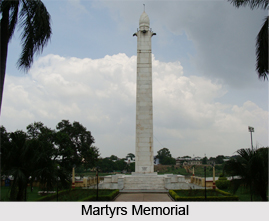 Meerut is a popular metropolitan city of the state of Uttar Pradesh. It is in fact, India`s 16th largest metropolitan city that holds extensive importance for the Mutiny of the Bengal Army in the year 1857. This fastest developing town of Uttar Pradesh has one of the largest Army cantonments of the country. Meerut, which is also known as the educational and industrial hub of India, is popular for its sports goods, scissors and enormous monuments and heritage sites. By the early 19th century it was a deserted town with little trade, but with the establishment of British cantonments here in 1806, the population expanded and trade flourished.
Meerut is a popular metropolitan city of the state of Uttar Pradesh. It is in fact, India`s 16th largest metropolitan city that holds extensive importance for the Mutiny of the Bengal Army in the year 1857. This fastest developing town of Uttar Pradesh has one of the largest Army cantonments of the country. Meerut, which is also known as the educational and industrial hub of India, is popular for its sports goods, scissors and enormous monuments and heritage sites. By the early 19th century it was a deserted town with little trade, but with the establishment of British cantonments here in 1806, the population expanded and trade flourished.
The `Military Cantonment` lying to the north of the old city is an extensive area running from the railway on the west to the police lines on the east. The principal thoroughfare of Meerut is the Mall, one of the finest examples in India, which provides a wide, tree-lined drive flanked by bungalows with fine garden compounds. The `Club and Roman Catholic Church` can be seen here. St John`s Church was built in a classical style in the year 1821, with a striking spire visible from the foothills of the Himalayas. This church has a rich historical significance as during the outbreak of the Mutiny, the British were at evening service in this church. North-west of the Church is the Cemetery, which is divided into two parts. The old part is covered with cupolas, pyramids and obelisks. General Sir David Ochterlony, whose memorial column stands in Kolkata and who served in every Indian war from the time of Clive onwards, terminating in the invasion of Nepal in 1816, was buried here in the year 1825. His tomb consists of a large commemorative plaque of ornamental brickwork carrying a marble slab and dedication. Another memorial is devoted to those officers and privates of the `14th Regiment of Foot` who fell in the storming of Bharatpur in between 1825 and 1826. `Victoria Park` marks the site of the old Central Jail, which was dishonourable during the events of 1857. The earlier antiquarian remains of Meerut are exquisite and highly notable. The `Suraj Kund` or `Monkey Tank` lies to the west of Victoria Park; it was constructed in the year 1714 by a rich merchant Jowahir Mai. Its sides are lined with small temples, sanctuaries and suttee pillars.
Another most popular monument of this city is the `Baleswar Nath Temple` depicts the Muslim conquest. Near the Collector`s Office lies the `Tomb of Makhdum Shah Wilayat` that was apparently built by Shahab-ud-Din Ghuri. The Tomb of Shah Pir is a fine red sandstone structure that was erected in the year 1628 by Nur Jahan, wife of Emperor Jahangir, in memory of a pious fakir. Qutb-ud-Din Aibak is alleged to have built the Maqbara of Salar Masa-ud Ghazi in the year 1194. The mausoleums of Abu Muhammad Kamboh (1658) and Abu Yar Khan (1577) are some other places of interest in Meerut.
Meerut, one of the developing and hugely popular cities of India, offers a number of places of interest to its visitors.



















